While we are used to seeing cities such as Delhi and Beijing take spots in the world’s top 10 most polluted cities, the past month has seen some unexpected cities enter and even take the crown for the most polluted cities in the world. Just a couple of weeks ago, New York took the top spot, with other nearby cities such as Detroit, Chicago, and Toronto also moving into the top 10. Why? Because of wildfire smoke.
As of the time of writing this article, Canada is experiencing the worst wildfire season on record. Unfortunately, this isn’t an isolated case as other countries, such as Australia, are also experiencing increasingly severe wildfires every year. While the impacts of the fires themselves are disastrous, the smoke from wildfires is an even bigger health concern.
Not only is wildfire smoke a transboundary issue, as it can impact countries thousands of miles away, but the pollutants emitted by the fires are incredibly harmful to human health. For this reason, even if you don’t live in a country that experiences wildfires, it’s essential to know how to protect yourself and to be prepared.
If you’re wondering about the health consequences of wildfire smoke or how you can protect yourself, you’ve come to the right place. In today’s article, I will discuss why wildfire smoke is such a big issue and how you can keep an eye on air quality to protect yourself. With that said, let’s dive in!
Subscribe to BreatheSafeAir
Air pollution is a silent killer that affects millions of people worldwide. Start protecting yourself today.
This post contains affiliate links. For more information, please refer to my affiliate disclaimer.
Information on this blog is for informational purposes only. Readers are encouraged to confirm the information herein with other sources. Furthermore, this information is not intended to replace medical advice from professionals. This website assumes no responsibility for the accuracy of the information, which is subject to change without notice.
How Bad Is Wildfire Smoke for You?
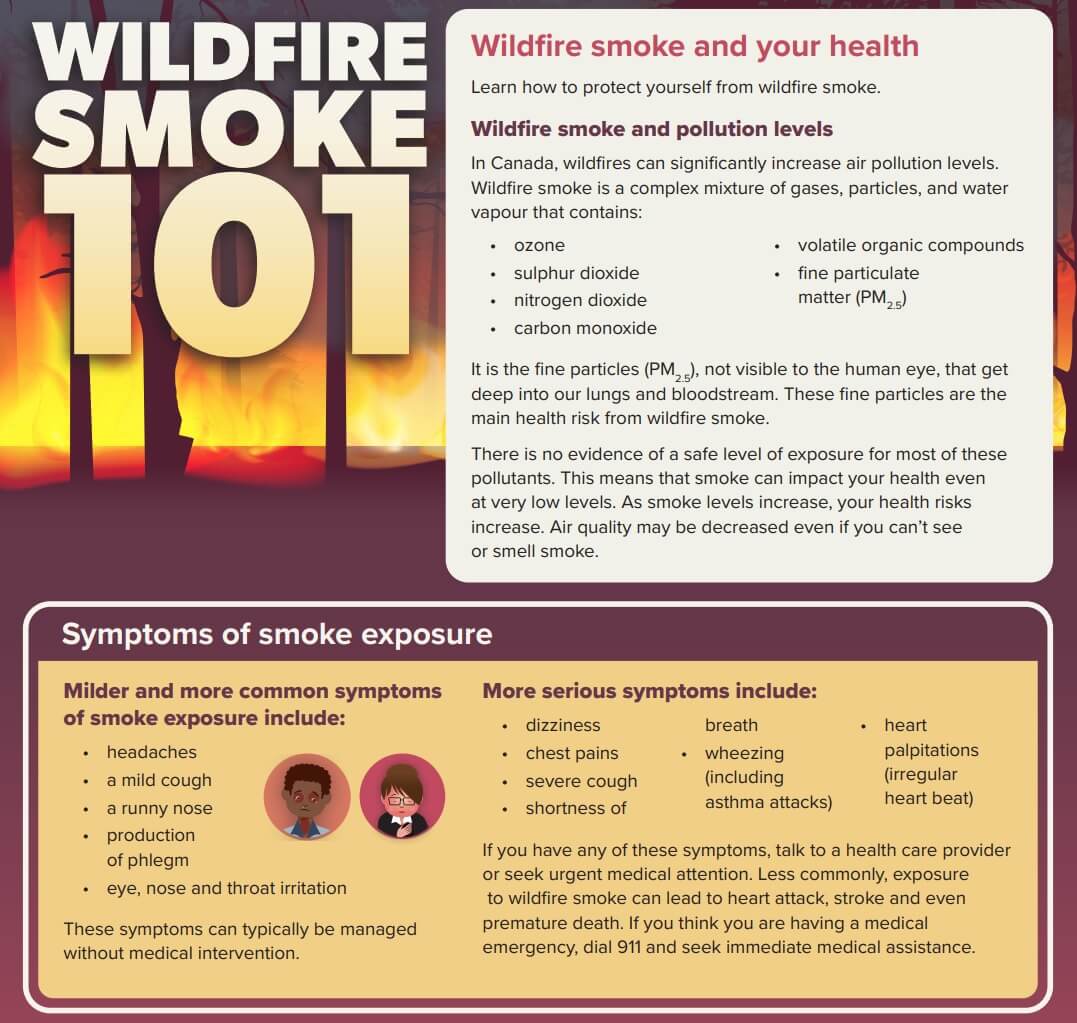
Image source: Government of Canada
I’ve discussed the dangers posed to the human body by air pollution, and wildfire smoke has a set of similar dangers – albeit with more severity due to the very high concentrations of pollutants that the fires emit. It’s vital to remember that wildfire smoke can impact anyone, even the healthiest people, and can have immediate health effects.
While wildfire smoke primarily comprises particle pollution (such as PM1.0, PM2.5, and PM10), it also contains a complex mixture of gases and water vapour. Some of the most common components of wildfire smoke are VOCs (volatile organic compounds), nitrogen dioxide, sulphur dioxide, and carbon monoxide (source).
However, these aren’t the only harmful gases we breathe when exposed to wildfire smoke. When smoke stays airborne for a prolonged period (a few days), the UV radiation from the sun interacts with the VOCs to form benzene and formaldehyde – this is why wildfire smoke can smell like plastic (source). Both of these toxic air pollutants are very hazardous to human health.
Particularly important to note is that there is no evidence of a safe level for any of these pollutants. Similar to how it’s been recently proven that there is no ‘safe’ level of air pollution, the pollutants from wildfire smoke are not considered safe at any level and carry health risks even at very low levels (source).
Perhaps the best way to explain the danger of wildfire smoke is to discuss it in cigarette equivalence. We’re all aware of the danger of smoking to human health, and Berkeley Earth has compared smoking to particulate pollutant levels. Below is a fantastic visualisation showing how many cigarettes you would’ve smoked just by spending a day outdoors in New York City on the 7th of June, 2023 (when the Canada wildfires were burning).
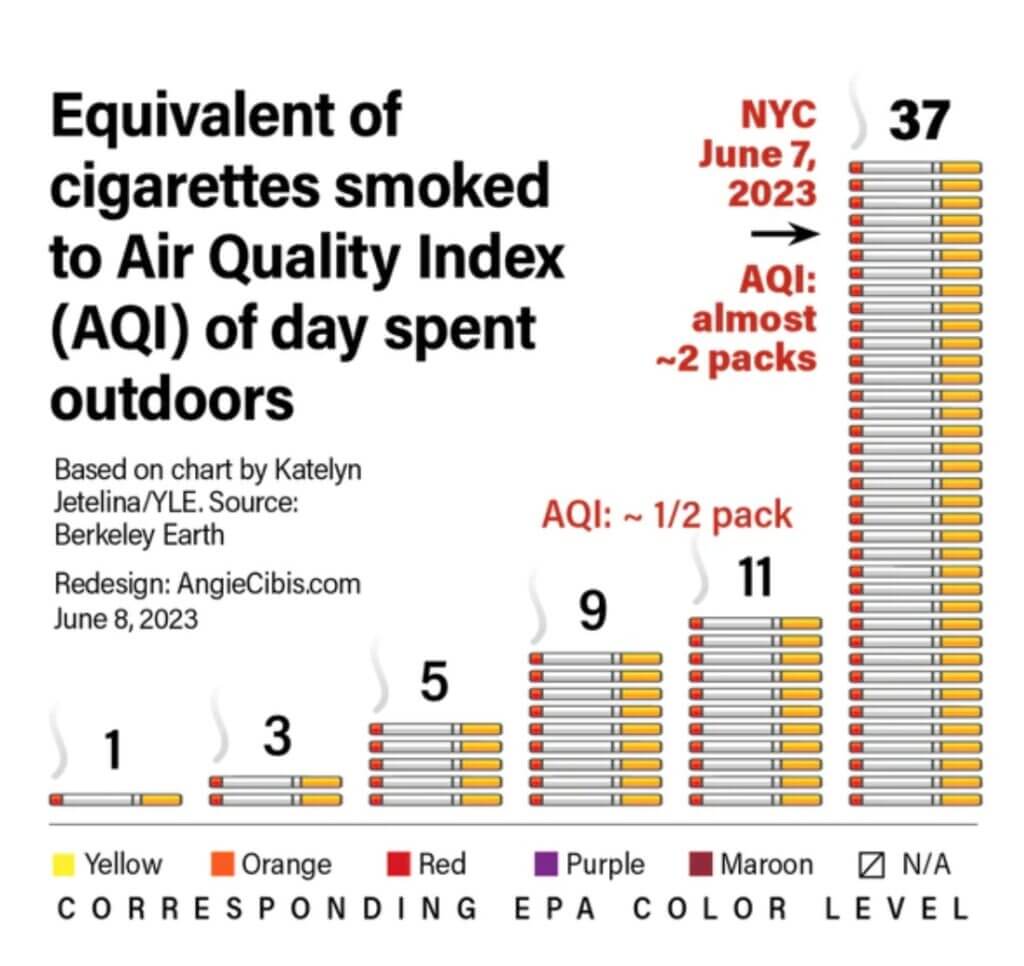
However, this calculation only accounts for particulate pollution such as PM2.5. As mentioned above, wildfire smoke is a mixture of many different pollutants – many equally or more harmful to human health. While ultrafine particles such as PM1.0 and PM2.5 are small enough to enter our lungs and even the bloodstream, making them a big cause for concern, each toxic gas has its danger.
So, what symptoms can we expect to experience when exposed to wildfire smoke? While each pollutant in wildfire smoke carries dangers at all levels, most people will only experience minor symptoms with short-term exposures (hours or days) at low concentrations. Some of these milder symptoms include:
- Headaches
- Mild cough
- Runny nose
- Production of phlegm
- Eye, nose and throat irritation
- Fast heartbeat
- Irritated sinuses
- Stinging eyes
However, one of the biggest dangers with wildfire smoke is that it often doesn’t carry just low concentrations of these dangerous particles and toxic gases. Instead, the haze often brings exceptionally high levels of pollutants that aren’t seen outside of wildfires. This can lead to more short-term serious impacts, such as:
- Dizziness
- Chest pains
- Severe cough
- Shortness of breath
- Wheezing
- Heart palpitations
The U.S. EPA also warns about severe short-term health effects such as bronchitis, reduced lung function, and even severe effects such as heart failure, heart attacks, and strokes. While these cases are rarer, they show the danger posed by wildfire smoke and the severity of the issue (source).
We currently don’t know much about the long-term impacts of wildfire smoke because no studies have investigated the dangers (source). However, we know that there are long-term dangers posed by wildfire smoke, and we can guess what these will be based on what we know about air pollution and fossil fuel pollution.
Long-term exposure to wildfire smoke will likely lead to higher rates of cardiovascular issues, pulmonary problems, and a greater risk of diabetes and dementia (source). As air pollution has been linked to mental conditions such as depression and even suicide, it’s likely that long-term exposure to wildfire smoke also has an impact on mental health.
While further research needs to be done to understand the long-term dangers of wildfire smoke fully, we know enough to know that it is something we should try our best to avoid whenever possible. It is guaranteed to carry health impacts, but we don’t know the severity of these issues.
Who Is Most At-Risk From Wildfire Smoke?

Image source: Minnesota Department of Health
As with most airborne pollutants, certain groups of people will be more at risk of health problems than others. These at-risk groups fall into three categories:
Age
- Seniors
- Infants
- Young children
Health Conditions
- Heart or lung conditions (such as asthma)
- Cancer
- Diabetes
Exposed Individuals
- Those who work outdoors
- Those who smoke
- Those who do strenuous outdoor exercise
Pregnant women are also at more risk from wildfire smoke, and if you fall into one of these categories, you should take extra precautions to minimise your exposure to the toxic fumes.
How Far Can Wildfire Smoke Impact People?

Image source: Airnow.gov
A common misconception about wildfire smoke is that it is generally limited to a country or region. However, this is far from true, as wildfire smoke is a cross-border issue that can impact millions who may not even be aware.
It’s hard to ignore the haze in the most heavily hit areas – just look at photos from New York and Chicago during the 2023 Canada wildfires. However, wildfire smoke can travel thousands of miles from the source, impacting neighbouring states, regions, and countries. Wildfire smoke can sometimes travel across one country and impact even non-neighbouring countries.
In these areas, the haze will be less visible. However, the air can still contain toxic fumes in lower concentrations. For this reason, it’s essential to prepare yourself for wildfire smoke, even if you live more than a thousand miles from a fire hotspot.
How to Check Wildfire Air Quality
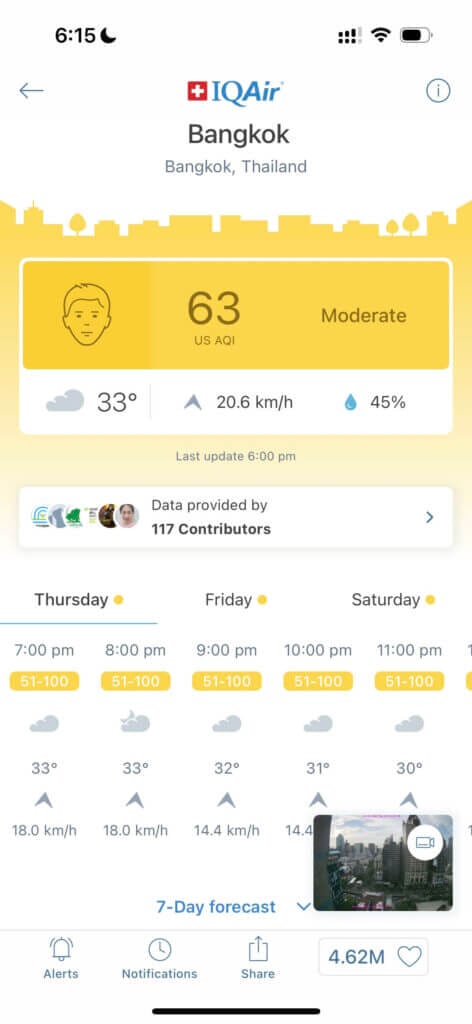

Air Visual application showing air quality in Thailand.
One of the most important things to do during wildfire season, if you live in or near a fire-prone area, is to check the air quality regularly. At a minimum, you’ll want to check the air quality every morning. This is especially important if you need to head to school, work, or go somewhere else daily.
However, I recommend checking the air quality a few times throughout the day, too, as conditions can change quickly. Winds and other weather conditions can cause pollutant concentrations to change rapidly and unexpectedly. While some of these changes will be visible to the naked eye, it can be hard to see more minor changes and checking the AQI regularly is necessary.
But that begs the question; if you’re looking to monitor the air quality and how wildfire smoke impacts it, how can you do so? The easiest way is with an AQI app, and I recently put together a list covering 10 of the best AQI apps. If you want a quick answer, here are the best apps for checking wildfire smoke:
- AirVisual. My go-to app as it has no advertisements and all of the essential data in a clean look. It also has the most data sources and integrates with AirVisual Air Quality Monitors.
- Plume Labs: Air Quality App. Many will prefer the more modern look of the Plume Labs: Air Quality App. It also has complete data for most cities and provides other features like a pollution hotspot map (for some cities).
- Air Matters. This app provides one of the most comprehensive AQI readings in a modern, helpful UI. The individual pollutants are broken down into their concentrations, and the app offers mitigation suggestions.
All of these AQI apps will allow you to keep an eye on wildfire smoke, and each of the three has an accompanying website which can be checked on a desktop. However, if you are checking the air quality on a desktop or a tablet, I recommend AQICN, as it has detailed breakdowns of each pollutant.
Wildfire Smoke Maps
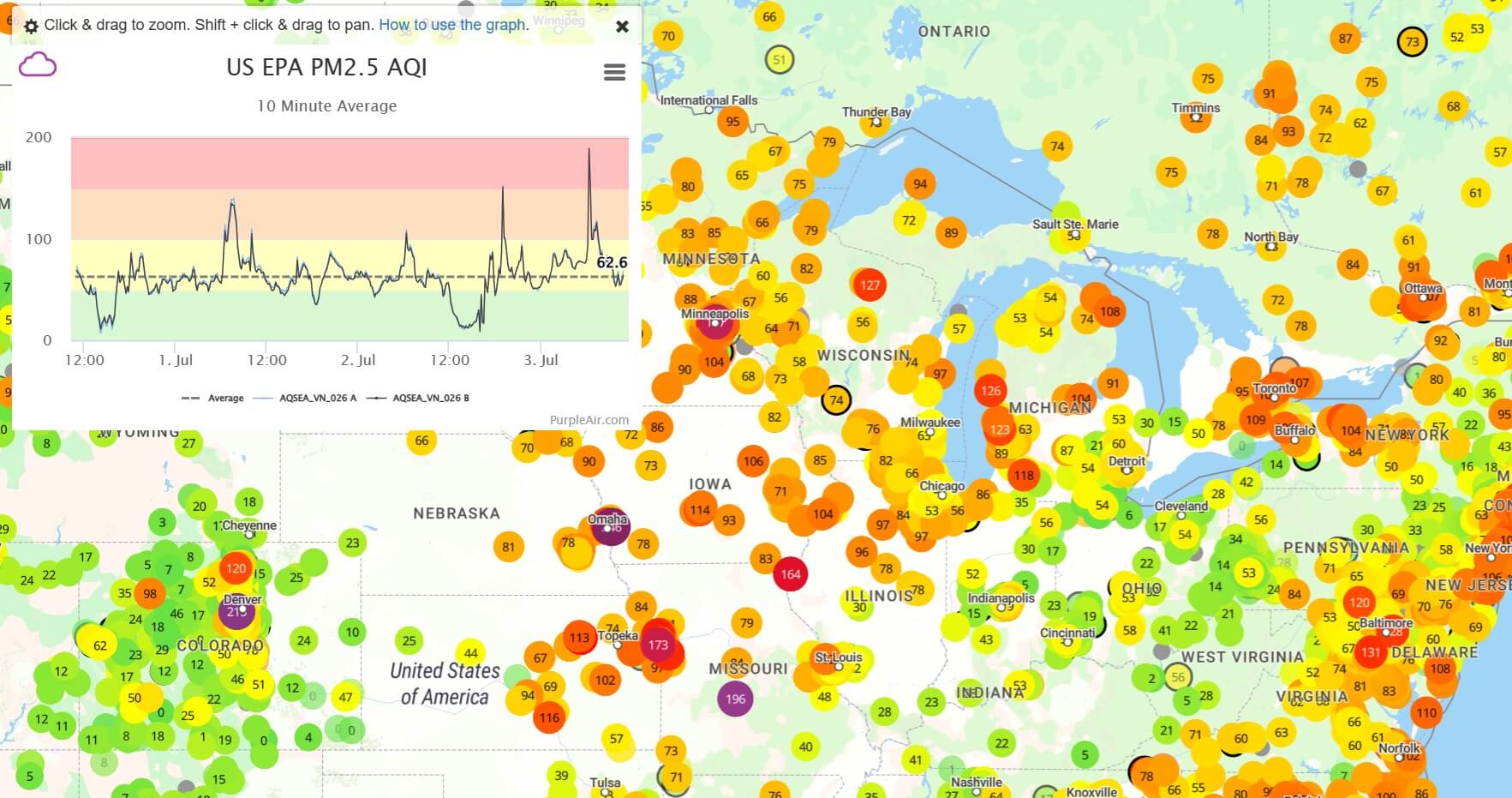
If you’re looking for something more detailed than an AQI map, you may want to look into pollution maps. Several platforms provide similar information, but one fantastic platform is Purple Air. Purple Air is a company that creates highly-accurate air quality monitors purchasable by anyone. Once you become a customer, you can supply your monitor’s data to the Purple Air network.
This community-driven wildfire map can be invaluable if you live in a country such as the U.S., Canada, or even the east coast of Australia. There is a multitude of different monitors located in each area, and you can view current data as well as historical data for each monitor. While there are fewer monitors in other countries, it’s well worth checking out, and this is one of my favourite platforms for keeping an eye on wildfire smoke.
If you live in the U.S., the AirNow map is another good choice. This map sources its data from government monitors located all around the United States. It even provides other benefits, such as showing active wildfire locations and the smoke clouds present.
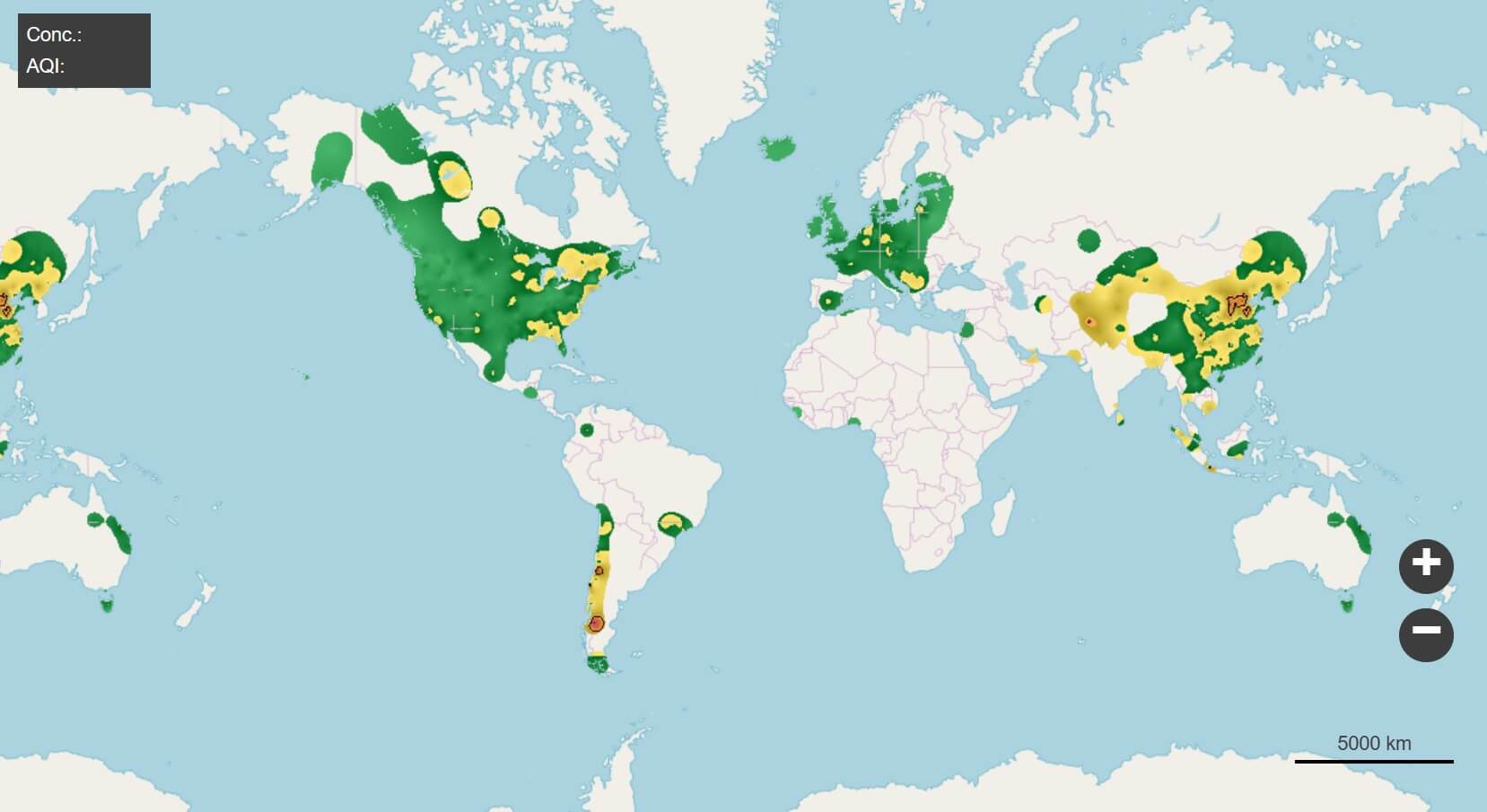
Berkely Earth runs one more wildfire smoke map. While I don’t find this map to be as intuitive, it has one fantastic feature: the ability to see historical data (by hour, day, or month). This is invaluable for viewing trends, which is why I regularly use this map.
Checking Indoor Air Quality
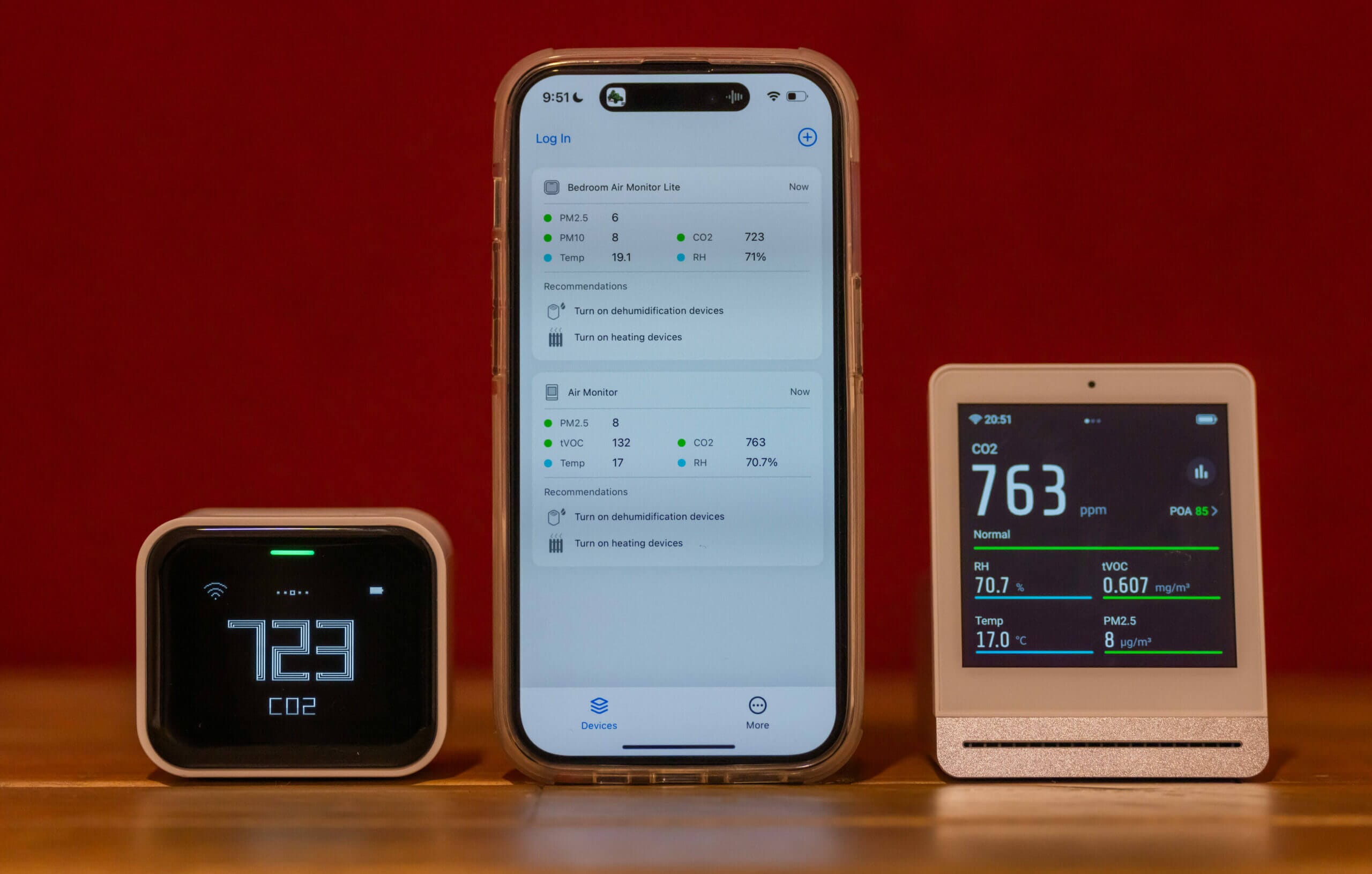
Qingping Air Quality Monitor Lite and Qingping Air Quality Monitor.
The most common advice for avoiding the adverse health impacts of wildfire smoke (which we will discuss in more detail soon!) is to stay indoors with the windows and doors shut and any HVAC systems set to recirculate (unless it’s introducing only filtered air). However, indoor air isn’t always clean either – in fact, indoor air often has two to five times higher concentrations of some pollutants (source).
Unfortunately, while monitoring outdoor air quality is as easy as downloading a free app on your smartphone, monitoring indoor air quality is a very different story. To accurately keep an eye on IAQ levels, you will need to purchase an air quality monitor.
These devices will give you regular updates on the air quality within your home or office. They typically monitor PM2.5, PM10, VOCs (volatile organic compounds) and occasionally other gases such as CO, CO2, O3, and NO2. While they come at a price, high-quality monitors can be found for as low as 80 USD.
While an indoor air quality monitor is a valuable tool for anyone – air quality can impact your health in many ways you won’t even realise until you have a monitor – they are handy if you live in a wildfire-prone area.
It can be easy to think you’re safe from wildfire smoke if you’ve closed the doors and windows. Unfortunately, this is often far from the truth. While these are the most common entry methods, wildfire smoke can also enter your home through joints, openings, and cracks in walls, floors, and ceilings. If you have extraction fans that aren’t in use, smoke can also quickly enter through these.
Having an indoor air quality monitor will allow you to identify if wildfire smoke is entering your home and will notify you if you have an entry point that you may otherwise be unaware of. For a breakdown of the best air quality monitors, please refer to this article on air quality monitors.
How to Protect Yourself From Wildfire Smoke

Staying Safe Indoors
- Cover Entry Points
The first and most crucial step to staying safe from wildfire smoke indoors is to cover and close all potential entry points. The most obvious way for wildfire smoke to enter homes is through open doors and windows, but there are also some other areas you will want to pay attention to.
If you have any gaps or cracks in your walls, ceiling, or floor, you will want to cover these. On top of this, inactive extraction fans in bathrooms and toilets can provide an infiltration point (yes, that is the word for wildfire smoke entering your home!) for smoke. If you have an extraction fan or other entry points, you will want to block these.
HVAC and ventilation systems can also allow wildfire smoke to enter your home. If you have such a system, make sure it’s set to recirculate air, as you don’t want to introduce new air into your home. While this air would usually be considered ‘fresh’ during wildfires, this is far from the case.
- Control Sources of Indoor Air Pollution
Since you will be locking down your home, it’s important not to generate further indoor air pollution – It’s not ideal to lock out wildfire smoke only to create more toxic fumes! I have a whole article discussing sources of indoor air pollution, and I recommend reading that if you want further information.
The most polluting activities involve burning candles or incense, smoking, or using gas, propane, or wood-burning stoves. If possible, you will want to avoid all of these activities as they are very detrimental to indoor air quality.
Cooking can also create large amounts of indoor air pollution – especially if food gets slightly burnt. For this reason, it’s best to run an air purifier after cooking. Alternatively, cooking food with a microwave creates fewer particles.
- Get an Air Purifier
Air purifiers are the only way to clean your indoor air when locking down due to wildfire smoke. Since fresh air can’t be introduced, it’s important to clean the air that’s circulating in your home – especially after cooking or doing another pollution-generating activity. An air purifier will also allow you to filter any particles that do manage to enter your home.
Purchasing the right air purifier can be a minefield, as there are so many options, and many of them don’t perform as well as they should. When it comes to air purifiers, I trust companies like Smart Air which focus on creating low-cost yet high-performance air purifiers.
Whichever air purifier you want to purchase, you will want to consider the filter type. HEPA (High-efficiency particulate air) filters are the best and filter ≥ 99.97% of particles. Below this, you MERV 16 (≥ 95%), MERV 15 (85-94.9%), MERV 14 (75-84.9%), etc. For wildfire smoke, I wouldn’t recommend anything below HEPA or, at worse, MERV 14.
If you don’t mind a bit of DIY, a Corsi-Rosenthal Box might be right up your alley. These simple boxes are inexpensive and can filter as much, if not more, than a traditional air purifier.
- Wash Yourself
An important step that is easy to forget is changing your clothing and showering as soon as you get home. If you need to venture out into the haze, you will quickly become covered in fine and ultrafine particles. When you enter your house, you bring these particles inside.
For this reason, it’s important to take off and wash your clothing as soon as possible. Furthermore, you will likely have particles on your skin, so taking a bath or shower to wash these particles off is very important.
- Use an Air Quality Monitor
Air quality monitors are devices that can monitor your home’s particulate and gas levels. While some of these devices are pricey, there are now many inexpensive options worth considering.
Having an air quality monitor will allow you to know exactly how clean your indoor air is and whether further actions are required. For example, these monitors can let you know when you need to turn on your air purifier or even when you have a source of indoor air pollution.
While these devices might seem unnecessary, they can quickly become a valuable investment if you live in a wildfire-prone area. Even when wildfires aren’t an issue, these devices are useful and will provide insights into indoor air quality.
- Find a Safe Place
If, for whatever reason, you can’t ensure clean air in your home, the last resort is to find a safe place to stay. While not ideal, it might be best to find a friend or family member you can stay with (assuming they have a safe indoor environment).
If you need to leave your house for the short term, consider heading to a local library, cafe, or other venue. Many of these will have clean air, which should be easy to identify before entering the venue. However, it’s important to note that areas such as public transport stations (trains and buses) and malls often don’t have sufficient filtration, and you will likely be breathing polluted air.
Staying Safe Outdoors

- Avoid The Outdoors
The first point might sound contradictory, but it’s true. The best thing you can do to stay safe outdoors during times of intense wildfire smoke is to avoid going outside as much as possible. It’s far safer to lock down inside your home than to go outside.
If you are in one of the at-risk groups mentioned above, you will want to take extra steps to avoid going outside wherever possible. If you fall into one of these groups and must go out, it’s more important than ever to don a respirator.
However, it’s impossible to stay inside at all times, and many of us will have commitments requiring us to leave the house. If this is the case, you will want to take the precautions below.
- Avoid Strenuous Activities
Another important step to avoiding the worst impacts of wildfire smoke is to avoid exercise and other physical activities. As we perform these activities, our breathing rate increases, and we breathe in vastly more pollutants.
If you usually exercise outdoors, consider finding a gym or another indoor venue that will allow you to continue exercising. If the smoke is only short-term, consider taking a break from outdoor exercise together.
If you are required to perform labour-intensive work outdoors, wear a well-fitting, high-filtration respirator capable of providing a good level of protection. While avoiding activities that will increase your respiratory rate is best, the next best alternative is a respirator.
- Wear a Respirator
That leads us to wearing a respirator. It’s best to avoid going outdoors whenever possible, but if you must go out, it’s essential to be prepared. When it comes to wildfire smoke, being prepared means having at least a few high-filtration respirators on hand.
Later in this article, I will discuss the best respirators for wildfire smoke, and I recommend referring to that section for more details. In short, you will want at least an N95 respirator; the most important factor is ensuring it fits well.
If you want a higher level of protection, an elastomeric half-face respirator is a good improvement. These respirators tend to fit better (but this is not a guarantee), and they usually provide a P100 level of protection.
- Check the AQI
Even throughout the day, the air quality can fluctuate massively. Changes in the weather, such as wind and rain, have a big impact on the number of airborne particles, and it’s possible to avoid the worst air quality by keeping an eye on weather conditions.
If you have time flexible plans, check the weather and look for upcoming wind changes or rain. If the wind changes direction, you may have a respite from the most severe wildfire smoke. The same goes for rain, which can bring the airborne particles to the ground.
Using an app or website like AQICN will also allow you to quickly view historical AQI data to identify trends in your local air quality. If there are, you can plan your outdoor trips around this information.
What Masks Are Good for Wildfire Smoke?
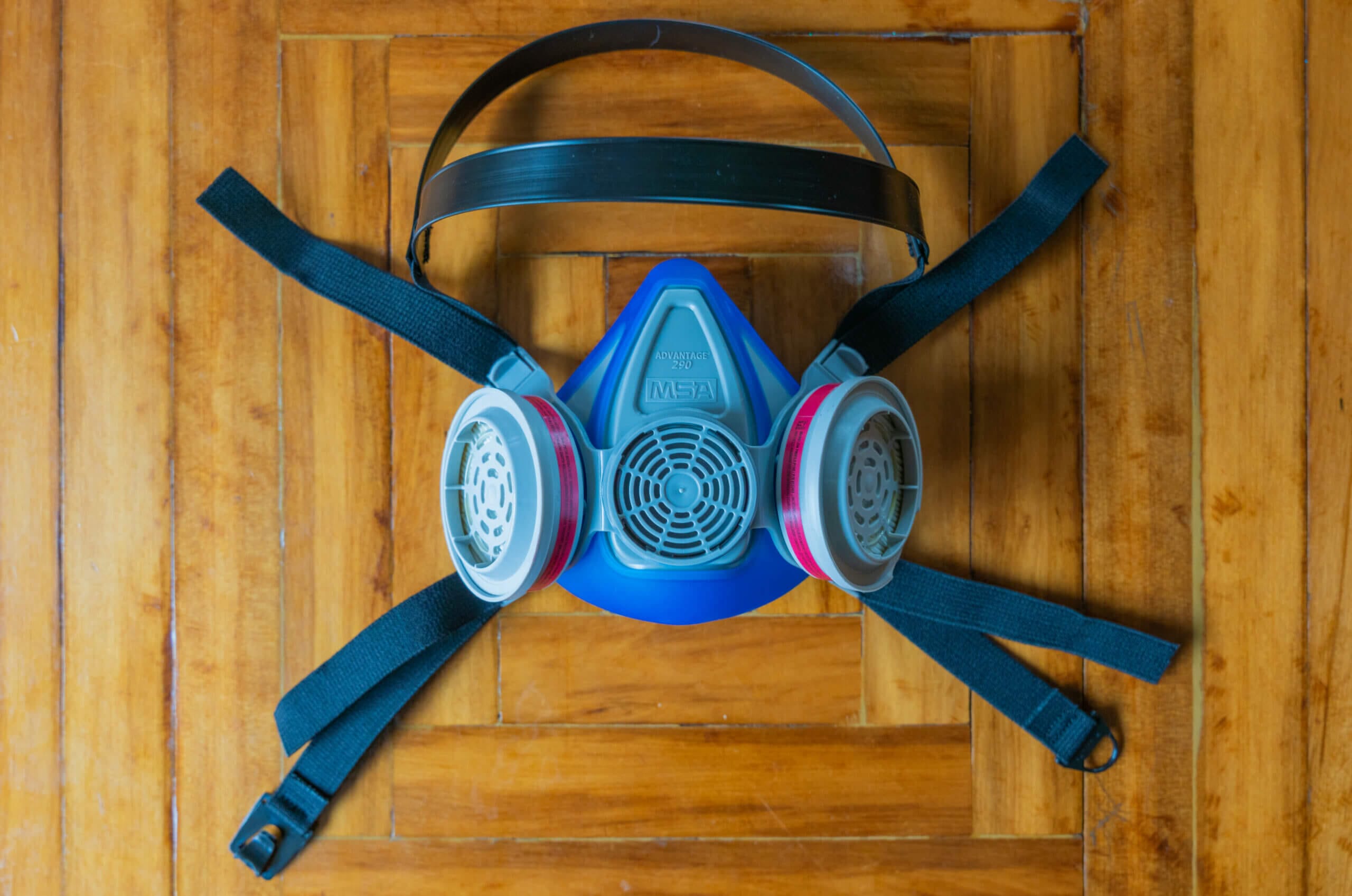
Important note on respirators and wildfire smoke: Respirators such as N95s and P100s will filter the particle pollution in wildfire smoke, but you will still be exposed to smoke-related gases. While this protection is better than nothing, you can achieve a much better level of protection with an elastomeric respirator using combination particle/gas filter cartridges.
When it comes to wildfire smoke, masks and respirators are our first line of defence. While it’s best to avoid the smoke wherever possible by staying indoors, there are times when we need to leave the house. If this is the case, ensuring you have high-quality masks on hand is vital.
The world of masks and respirators isn’t straightforward, as there are many different rating systems and classes within each system. Nearly everyone will be aware of N95 respirators, but did you know there are also N99, N100, R95, R99, R100 and P100 devices? On top of this, you also have rating systems from other countries such as Australia, South Korea, China and more.
If you want to learn the intricacies of each standard and how they compare, please refer to this article on mask ratings. It goes into far more detail on each standard and will give you a complete understanding of its performance. However, if you’re looking for a quick answer to the question ‘What masks are best for wildfire smoke’, here are my suggestions:
- Wear N95/KN95/FFP2/P2 (94 or 95% filtration) at a minimum. Higher classes are better.
- Opt for headband respirators where possible. Earloops provide a much less secure fit.
- Tri-fold respirators tend to provide the best fit on average (models such as the 3M Aura have a very high fit test pass rate)
There are two main things to remember regarding masks for wildfire smoke. Firstly, surgical masks and cloth masks will not provide an adequate level of protection. These masks are designed for source control, meaning they aim to prevent expelled respiratory particles from becoming airborne. They aren’t designed to provide filtration against inhaled particles.
Secondly, it’s important to note that respirators are only effective if they are fitted correctly with no leaks present. Since most of us don’t have access to professional fit testing (required for respirator use in medical settings), the best we can do to ensure a fit is to conduct a seal check.
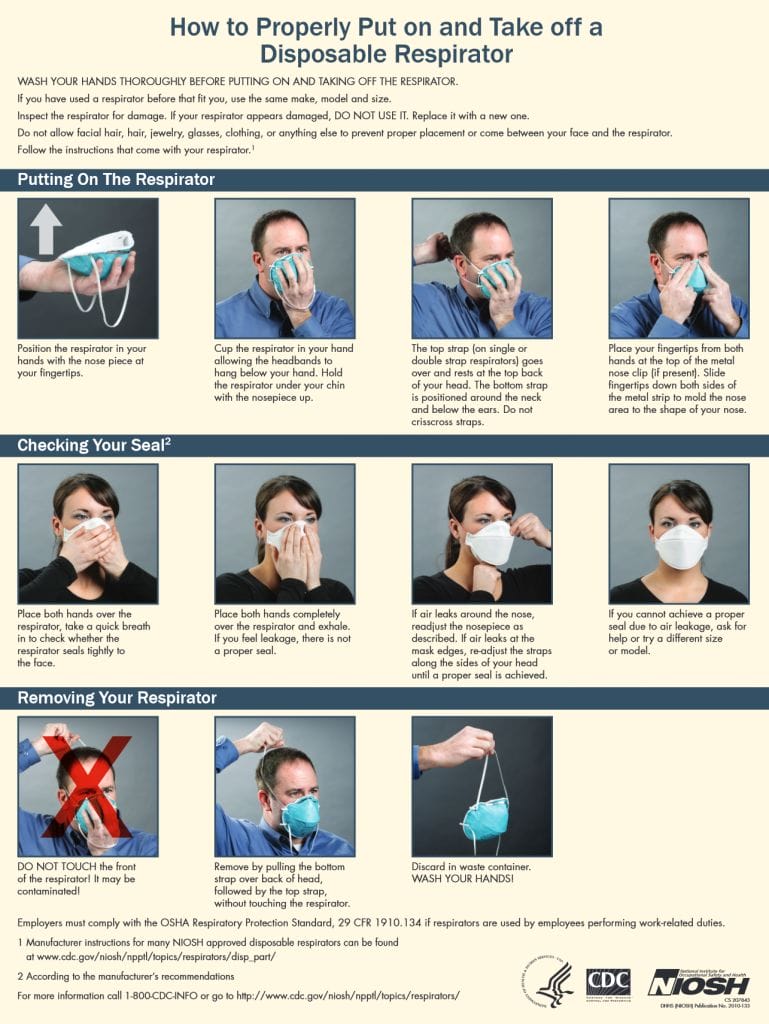
Filtering facepiece respirators (such as the N95s pictured above) are the most common form of respirator, but if you live in a wildfire-prone area or in an area that is impacted by wildfire smoke, it might be worth investing in a half-face respirator. These respirators are larger and use filter cartridges and elastomeric seals.
While these respirators may seem overkill, no one will give you a second glance if you wear them during extremely polluted days. Where filtering facepiece respirators are often finicky with fit (and finding one that fits you can be time-consuming and costly), half-face respirators tend to provide most users with a more secure seal. Of course, half-face respirators are still not guaranteed to fit and performing a seal check is still important.
Furthermore, half-face respirators have interchangeable filters, the highest level of which is usually P100. P100 filters offer ≥ 99.97% filtration, as opposed to the ≥ 95% offered by N95s. When conditions are as bad as they often are during wildfire season, this extra level of filtration can greatly reduce your exposure.
For example, assuming an N95 and P100 perform exactly at their required filtration level (they tend to perform above), if there are 1000 particles, 50 will pass through an N95s filter media. On the other hand, not even one will pass through the P100 filter media.
Mask Recommendations
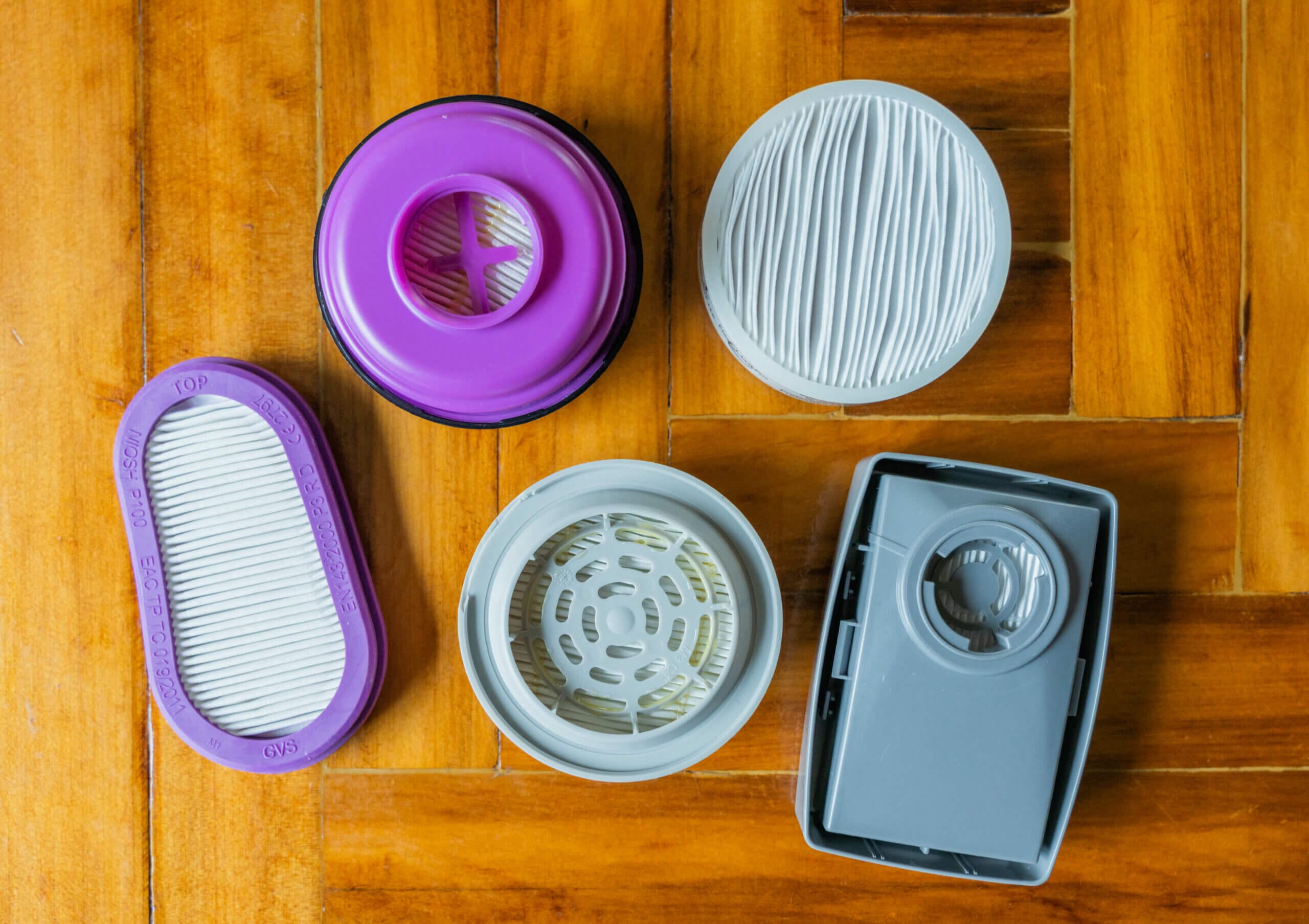
If you’re looking for mask recommendations, I have a few to make based on my experience. However, it’s important to note that these are general recommendations, and no respirator universally fits. Please treat these recommendations only as a guideline, and pick the respirator that best fits you.
Filtering Facepiece Respirators
- 3M Aura (9205+, 9210+, 1970+) | Buy on Amazon
- Drager X-plore (1900/1950) | Buy on Amazon
- Trident P2 Surgical Disposable Respirator | Buy from Trident (Australia)
- Vitacore CAN99 Surgical Respirator | Buy from Vitacore (Canada)
I could recommend many more filtering facepiece respirators for wildfire smoke protection, but since the fit is so subjective, I only feel confident recommending tri-fold respirators as they tend to provide the best fit across a range of faces. If you’re interested in more suggestions, please refer to this article on disposable respirators.
Half Face Respirators
- GVS Elipse (P100) | Buy on Amazon
- 3M 6000 or 7000 series (P100, Multi Gas/Vapour Cartridge) | Buy on Amazon
- Dentec Comfort Air 400 (P100, Multi Gas/Vapour Cartridge) | Buy from Dentec Safety
The GVS Elipse is the least flexible of the above half-face respirators as it only supports P100 filters, but I know many people appreciate the more compact sizing. If you want the flexibility to change filters and have access to gas and vapour filters, the 3M and Dentec respirators are a better choice.
Above half-face respirators, there are full-face respirators which will also protect your eyes, but I have limited experience with these respirators and, therefore, can’t make any recommendations.
Wildfire Smoke FAQ
Is It Safe to Breathe Wildfire Smoke?
No. Wildfire smoke contains a range of toxic gases and particles and should never be breathed if it can be avoided.
How Do You Protect Yourself From Wildfire Smoke?
The best way to protect yourself from wildfire smoke is to stay indoors and remove entry points for smoke. If you must go outside, a respirator is your best line of defence.
What Is in Wildfire Smoke?
Wildfire smoke contains many fine and ultrafine particles alongside VOCs, carbon monoxide, nitrogen dioxide, sulphur dioxide and more. All of these pollutants are harmful to human health.
Are Masks Effective Against Wildfire Smoke
Yes! If you have a high-filtration respirator such as an N95 that is fitted correctly masks are effective against wildfire smoke.
Have Questions or Comments?
Join the discussion on the BreatheSafeAir Community Forum. Ask any questions you have about air quality or adjacent topics and get quick answers!